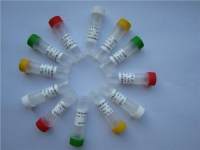Detection of DNA-Dependent Protein Kinase in Extracts from Human and Rodent Cells
互联网
954
The DNA-dependent protein kinase, DNA-PK, is required for DNA double-strand break repair and V(D)J recombination (1 –3 ). DNA-PK is composed of a large catalytic subunit of approx 460 kDa (DNA-PKcs) and a heterodimeric DNA targeting subunit, Ku. Ku is composed of 70-kDa and approx 80-kDa subunits (called Ku70 and Ku80, respectively) and targets DNA-PKcs to ends of double-stranded DNA. DNA-PKcs is related by amino acid sequence to the phosphatidyl inositol kinase (PI-3 kinase) protein family (4 ), however, in vitro DNA-PK acts as a serine/threonine protein kinase (5 –3 ). The physiological substrates of DNA-PK are not known, however in vitro DNA-PK is known to phosphorylate many proteins including hsp90, SV40 large T antigen, serum response factor, and p53 (reviewed in ref. 1 ). In these substrates, DNA-PK phosphorylates serine (or threonine) that is followed by glutamine (an “SQ motif”) (8 ), although some DNA-PK substrates are phosphorylated at “non-SQ” sites (9 ). A synthetic peptide, derived from amino acids 11–24 of human p53, that contains an “SQ motif” is a specific substrate of DNA-PK, whereas a similar peptide in which the glutamine is displaced from the serine by one amino acid is not phosphorylated (8 ). These peptides have been used to assay for DNA-PK activity in extracts from human tissue culture cells (8 –10 ) and normal human cells (11 ). DNA-PK activity is readily detected in extracts from human and monkey cell lines but not in protein extracts from nonprimate cells that, for reasons that are not well understood, contain 50- to 100-fold less DNA-PK activity (8 ,10 ,12 ). DNA-PK activity in nonprimate cells is detected using the same peptide substrates, but using a more sensitive “DNA-cellulose pulldown” assay in which cellular proteins are prebound to double-stranded (ds) DNA cellulose resin and assayed on the resin using the dsDNA cellulose itself as the activator (12 ,13 ). Here, we describe these methods for the assay and detection of DNA-PK in extracts from human and rodent cells. It is important to note that both of these assays are useful for quantifying the amount of DNA-PK present that can be activated by exogenous DNA; however, at present, no assay is available to measure the amount of DNA-PK that is actually active in a cell at any particular time.









